Risk Assessment and Regionalization of Fire Disaster Based on Analytic Hierarchy Process and MODIS Data: A Case Study of Inner Mongolia, China
Abstract
1. Introduction
2. Materials and Methodology
2.1. Study Area
2.2. Remote Sensing Data
2.2.1. Burned Area and Fire Hotspots Datasets
2.2.2. Validation Dataset
2.3. Selection of Environmental Variables
2.3.1. Climatic Variables
2.3.2. Vegetation Feature
2.3.3. Topographic Factors
2.3.4. Human Influence
2.4. Generation of Fire Risk Maps
2.5. Validation Approach
3. Results
3.1. Accuracy Verification of MODIS
3.2. Spatial–Temporal Variability of Fires
3.3. Correlation between Driving Factors and Fire Regime
3.4. Fire Risk Mapping
4. Discussion
5. Conclusions
Author Contributions
Funding
Conflicts of Interest
References
- Chuvieco, E.; Martínez, S.; Román, M.V.; Hantson, S.; Pettinari, M.L. Integration of ecological and socio-economic factors to assess global vulnerability to wildfire. Glob. Ecol. Biogeogr. 2014, 23, 245–258. [Google Scholar] [CrossRef]
- Wan, S.; Hui, D.; Luo, Y. Fire Effects on Nitrogen Pools and Dynamics in Terrestrial Ecosystems: A Meta-Analysis. Ecol. Appl. 2001, 11, 1349–1365. [Google Scholar] [CrossRef]
- Calvo, L.; Tárrega, R.; Luis, E.D. Secondary succession after perturbations in a shrubland community. Acta Oecol. 2002, 23, 393–404. [Google Scholar] [CrossRef]
- Lloret, F.; Calvo, E.; Pons, X.; Díaz-Delgado, R. Wildfires and landscape patterns in the Eastern Iberian Peninsula. Landsc. Ecol. 2002, 17, 745–759. [Google Scholar] [CrossRef]
- Martinez, J.; Vega-Garcia, C.; Chuvieco, E. Human-caused wildfire risk rating for prevention planning in Spain. J. Environ. Manag. 2009, 90, 1241–1252. [Google Scholar] [CrossRef] [PubMed]
- Zumbrunnen, T.; Menendez, P.; Bugmann, H.; Conedera, M.; Gimmi, U.; Burgi, M. Human impacts on fire occurrence: A case study of hundred years of forest fires in a dry alpine valley in Switzerland. Reg. Environ. Chang. 2012, 12, 935–949. [Google Scholar] [CrossRef]
- Rodrigues, M.; de la Riva, J.; Fotheringham, S. Modeling the spatial variation of the explanatory factors of human-caused wildfires in Spain using geographically weighted logistic regression. Appl. Geogr. 2014, 48, 52–63. [Google Scholar] [CrossRef]
- Burgan, R.E.; Klaver, R.W.; Klaver, J.M. Fuel Models and Fire Potential from Satellite and Surface Observations. Int. J. Wildland Fire 1998, 8, 159–170. [Google Scholar] [CrossRef]
- Clark, J.S. Effect of climate change on fire regimes in northwestern Minnesota. Nature 1988, 334, 233–235. [Google Scholar] [CrossRef]
- Neary, D.G.; Klopatek, C.C.; Debano, L.F.; Ffolliott, P.F. Fire effects on belowground sustainability: A review and synthesis. For. Ecol. Manag. 1999, 122, 51–71. [Google Scholar] [CrossRef]
- Chang, Y.; Zhu, Z.L.; Chen, H.W.; Hu, Y.M.; Bu, R.C.; Feng, Y.T.; Wang, Z.C. Predicting fire occurrence patterns with logistic regression in Heilongjiang Province, China. Landsc. Ecol. 2013, 28, 1989–2004. [Google Scholar] [CrossRef]
- Liu, Z.H.; Yang, J.; Chang, Y.; Weisberg, J.P.; He, S.H. Spatial patterns and drivers of fire occurrence and its future trend under climate change in a boreal forest of Northeast China. Glob. Chang. Biol. 2012, 18, 2041–2056. [Google Scholar] [CrossRef]
- Chang, Y.; Zhu, Z.L.; Feng, Y.T.; Li, Y.H.; Bu, R.C.; Hu, Y.M. The spatial variation in forest burn severity in Heilongjiang Province, China. Nat. Hazards 2016, 81, 981–1001. [Google Scholar] [CrossRef]
- Fang, L.; Yang, J.; Zu, J.X.; Li, G.C.; Zhang, J.S. Quantifying influences and relative importance of fire weather, topography, and vegetation on fire size and fire severity in a Chinese boreal forest landscape. For. Ecol. Manag. 2015, 356, 2–12. [Google Scholar] [CrossRef]
- Hu, T.; Zhou, G. Drivers of lightning-and human-caused fire regimes in the Great Xing’an Mountains. For. Ecol. Manag. 2014, 329, 49–58. [Google Scholar] [CrossRef]
- Guo, F.T.; Su, Z.W.; Wang, G.Y.; Sun, L.; Tigabu, M.; Yang, X.J.; Hu, H.Q. Understanding fire drivers and relative impacts in different Chinese forest ecosystems. Sci. Total Environ. 2017, 605, 411–425. [Google Scholar] [CrossRef]
- NFGA. Rank of the Regionalization on Nationwide Forest Fire Risk (LY/T 1063--2008); Standards Press of China: Beijing, China, 2008. [Google Scholar]
- Zhang, J.; Fan, J.; Liu, X.; Yang, H.; Tong, Z. Assessment and Prediction of Grassland Fire Disaster in Hulunbeir. J. Catastrophol. 2010, 25, 35–38. [Google Scholar]
- Liu, G.; He, S.U.; Shilei, L.I. The Summarization on the Fire Accident of Grassland in Inner Mongolia. Grassl. China 1999, 4, 76–78. [Google Scholar]
- Zhao, F. Changes in the Occurring Date of Forest Fires in the Inner Mongolia Daxing’anling Forest Region Under Global Warming. Sci. Silvae Sin. 2009, 473, 377–403. [Google Scholar]
- Zhang, J. Forestry Statistical Yearbook of China; China Forestry Publishing House: Beijing, China, 2014. [Google Scholar]
- IMSY. Inner Mongolia Statistical Yearbook; China Statistical Publishing House: Beijing, China, 2014. [Google Scholar]
- Fang, H. Science Yearbook; Technology and Science Publishing House: Shanghai, China, 1988. [Google Scholar]
- Eskandari, S.; Chuvieco, E. Fire danger assessment in Iran based on geospatial information. Int. J. Appl. Earth Obs. Geoinf. 2015, 42, 57–64. [Google Scholar] [CrossRef]
- Hong, H.; Jaafari, A.; Zenner, E.K. Predicting spatial patterns of wildfire susceptibility in the Huichang County, China: An integrated model to analysis of landscape indicators. Ecol. Indic. 2019, 101, 878–891. [Google Scholar] [CrossRef]
- Nieto, H.; Aguado, I.; García, M.; Chuvieco, E. Lightning-caused fires in Central Spain: Development of a probability model of occurrence for two Spanish regions. Agric For. Meteorol. 2012, 162–163, 35–43. [Google Scholar] [CrossRef]
- Mar, B.; Eduardo, C.; Manuel, J.S.-T. Application of artificial neural networks and logistic regression to the prediction of forest fire danger in Galicia using MODIS data. Int. J. Wildland Fire 2012, 21, 1025–1029. [Google Scholar]
- Sakr, G.E.; Elhajj, I.H.; Mitri, G. Efficient forest fire occurrence prediction for developing countries using two weather parameters. Eng. Appl. Artif. Intell. 2011, 24, 888–894. [Google Scholar] [CrossRef]
- Vasilakos, C.; Kalabokidis, K.; Hatzopoulos, J.; Matsinos, I. Identifying wildland fire ignition factors through sensitivity analysis of a neural network. Nat. Hazards 2009, 50, 125–143. [Google Scholar] [CrossRef]
- Maeda, E.E.; Formaggio, A.R.; Shimabukuro, Y.E.; Arcoverde, G.F.B.; Hansen, M.C. Predicting forest fire in the Brazilian Amazon using MODIS imagery and artificial neural networks. Int. J. Appl. Earth Obs. Geoinf. 2009, 11, 265–272. [Google Scholar] [CrossRef]
- Oliveira, S.; Oehler, F.; San-Miguel-Ayanz, J.; Camia, A.; Pereira, C.M.J. Modeling spatial patterns of fire occurrence in Mediterranean Europe using Multiple Regression and Random Forest. For. Ecol. Manag. 2012, 275, 117–129. [Google Scholar] [CrossRef]
- Zhang, L.; Verma, B. A deep neural network and rule-based technique for fire risk identification in video frames. Pattern Anal. Appl. 2019, 22, 187–203. [Google Scholar] [CrossRef]
- Puri, K.; Areendran, G.; Raj, K.; Mazumdar, S.; Joshi, K.P. Forest fire risk assessment in parts of Northeast India using geospatial tools. J. For. Res. 2011, 22, 641–647. [Google Scholar] [CrossRef]
- Mundo, A.I.; Wiegand, T.; Kanagaraj, R.; Kitzberger, T. Environmental drivers and spatial dependency in wildfire ignition patterns of northwestern Patagonia. J. Environ. Manag. 2013, 123, 77–87. [Google Scholar] [CrossRef]
- Manzo-delgado, L.; Sánchez-Colón, S.; Álvarez, R. Assessment of seasonal forest fire risk using NOAA-AVHRR: A case study in central Mexico. Int. J. Remote Sens. 2009, 30, 4991–5013. [Google Scholar] [CrossRef]
- Levin, N.; Heimowitz, A. Mapping spatial and temporal patterns of Mediterranean wildfires from MODIS. Remote Sens. Environ. 2012, 126, 12–26. [Google Scholar] [CrossRef]
- Armenteras-Pascual, D.; Retana-Alumbreros, J.; Molowny-Horas, R.; Roman-Cuesta, R.M.; Gonzalez-Alonso, F.; Morales-Rivas, M. Characterising fire spatial pattern interactions with climate and vegetation in Colombia. Agric. For. Meteorol. 2011, 151, 279–289. [Google Scholar] [CrossRef]
- Ren, Z.C.; Zhu, H.Z.; Liu, X.N. Spatio-temporal differentiation of land covers on annual scale and its response to climate and topography in arid and semi-arid region. Trans. Chin. Soc. Agric. Eng. 2012, 28, 205–214. [Google Scholar]
- Wei, B.; Xie, Y.; Jia, X.; Wang, X.; He, H.; Xue, X. Land use/land cover change and it’s impacts on diurnal temperature range over the agricultural pastoral ecotone of Northern China. Land Degrad. Dev. 2018, 29, 3009–3020. [Google Scholar] [CrossRef]
- Jackson, J.T.; Vine, L.M.D.; Hsu, Y.A.; Oldak, A.; Starks, J.P.; Swift, T.C.; Isham, D.J.; Haken, M. Soil moisture mapping at regional scales using microwave radiometry: The Southern Great Plains hydrology experiment. IEEE Trans. Geosci. Remote Sens. 1999, 37, 2136–2151. [Google Scholar] [CrossRef]
- Saaty, T.L. The Analytic Hierarchy Process; McGraw Hill: New York, NY, USA, 1980. [Google Scholar]
- Bowman, D.M.J.S.; Balch, J.K.; Artaxo, P.; Bond, W.J.; Carlson, J.M.; Cochrane, M.A.; Antonio, C.M.D.; DeFries, R.S.; Doyle, J.C.; Harrison, S.P.; et al. Fire in the earth system. Science 2009, 324, 481–484. [Google Scholar] [CrossRef]
- IPCC. Summary for Policymakers of Climate Change 2013: The Physical Science Basis; Cambridge University Press: Cambridge, UK, 2013. [Google Scholar]
- Miller, J.D.; Thode, A.E. Quantifying burn severity in a heterogeneous landscape with a relative version of the delta Normalized Burn Ratio (dNBR). Remote Sens. Environ. 2007, 109, 66–80. [Google Scholar] [CrossRef]
- Tessler, N.; Wittenberg, L.; Malkinson, D.; Beeri, O.; Halutzy, A. Spatial and temporal patterns of vegetation recovery following sequences of forest fire in a Mediterranean landscape, Mt. Carmel Israel. Catena 2007, 71, 76–83. [Google Scholar]
- Hegeman, E.E.; Zachmann, J.L.; Dickson, G.B. Probabilistic models of fire occurrence across National Park Service units within the Mojave Desert Network, USA. Landsc. Ecol. 2014, 29, 1587–1600. [Google Scholar] [CrossRef]
- Pan, J.; Wang, W.; Li, J. Building probabilistic models of fire occurrence and fire risk zoning using logistic regression in Shanxi Province, China. Nat. Hazards 2016, 81, 1879–1899. [Google Scholar] [CrossRef]
- Wang, L.T.; Zhou, Y.; Zhou, W.Q.; Wang, S.X. Fire danger assessment with remote sensing: A case study in Northern China. Nat. Hazards 2013, 65, 819–834. [Google Scholar] [CrossRef]
- Lozano, J.F.; Suárez-Seoane, S.; Kelly, M.; Luis, E. A multi-scale approach for modeling fire occurrence probability using satellite data and classification trees: A case study in a mountainous Mediterranean region. Remote Sens. Environ. 2008, 112, 708–719. [Google Scholar] [CrossRef]
- Li, X. Study of Forest and Grasslands Conflagration Law and Early Warning in the North-East of Inner Mongolia; Chinese Academy of Agricultural Sciences: Beijing, China, 2007. [Google Scholar]
- Calvino-Cancela, M.; Chas-Amil, L.M.; García-Martínez, D.E.; Touza, J. Interacting effects of topography, vegetation, human activities and wildland-urban interfaces on wildfire ignition risk. For. Ecol. Manag. 2017, 397, 10–17. [Google Scholar] [CrossRef]
- Guo, F.; Innes, L.J.; Wang, G.; Ma, X.; Sun, L.; Hu, H.; Su, Z. Historic distribution and driving factors of human-caused fires in the Chinese boreal forest between 1972 and 2005. J. Plant Ecol. 2015, 8, 480–490. [Google Scholar] [CrossRef]
- Tian, X.R.; Zhao, F.J.; Shu, L.F.; Wang, M.Y. Distribution characteristics and the influence factors of forest fires in China. For. Ecol. Manag. 2013, 310, 460–467. [Google Scholar] [CrossRef]
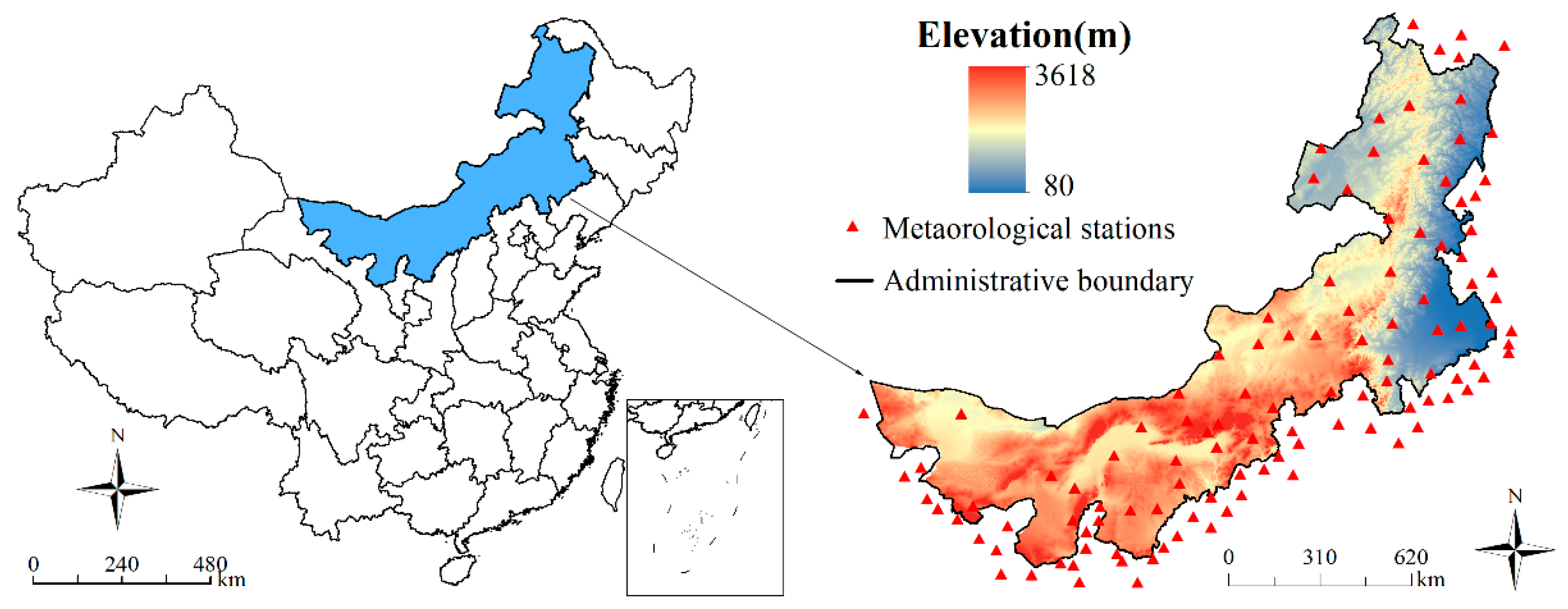
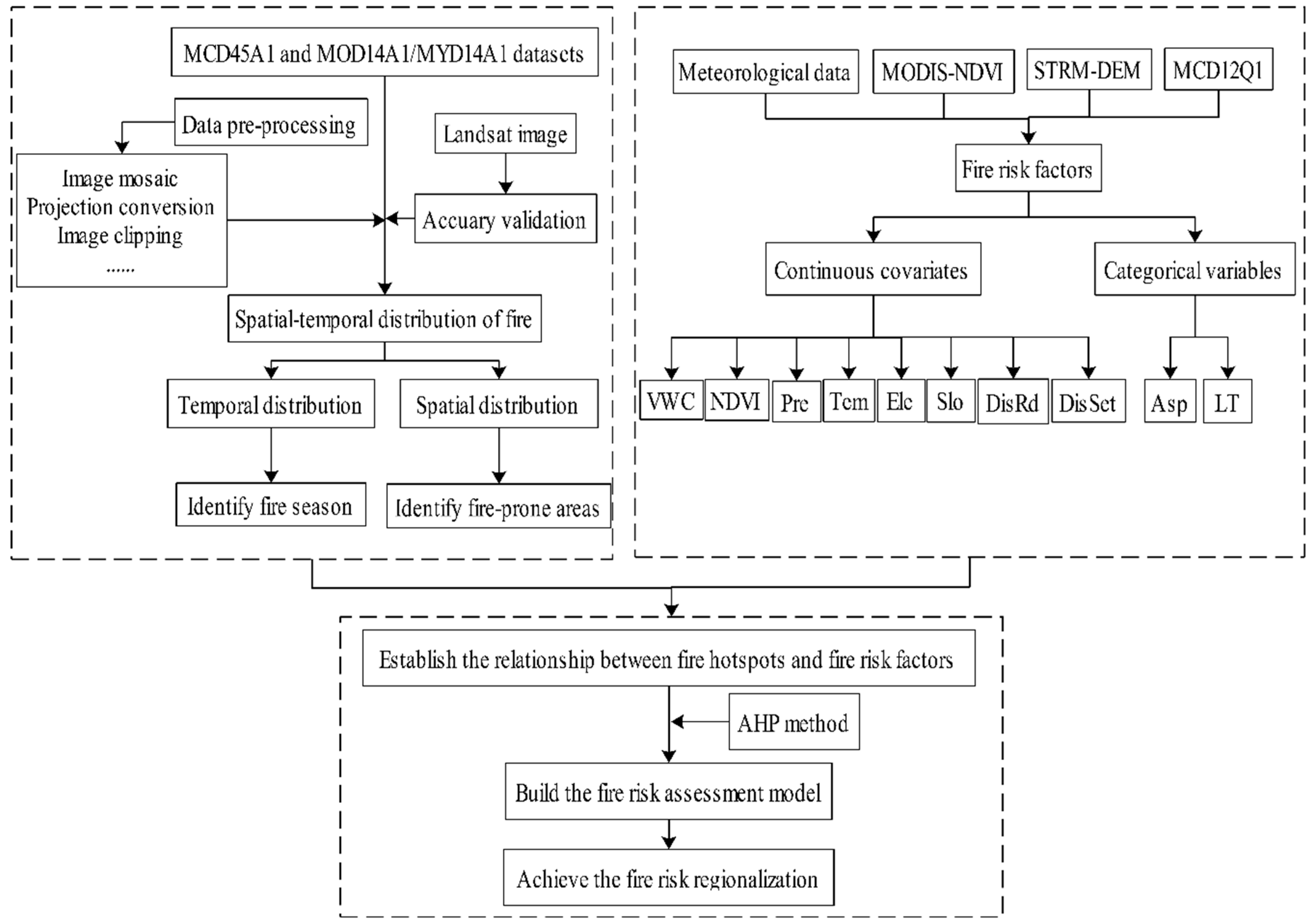
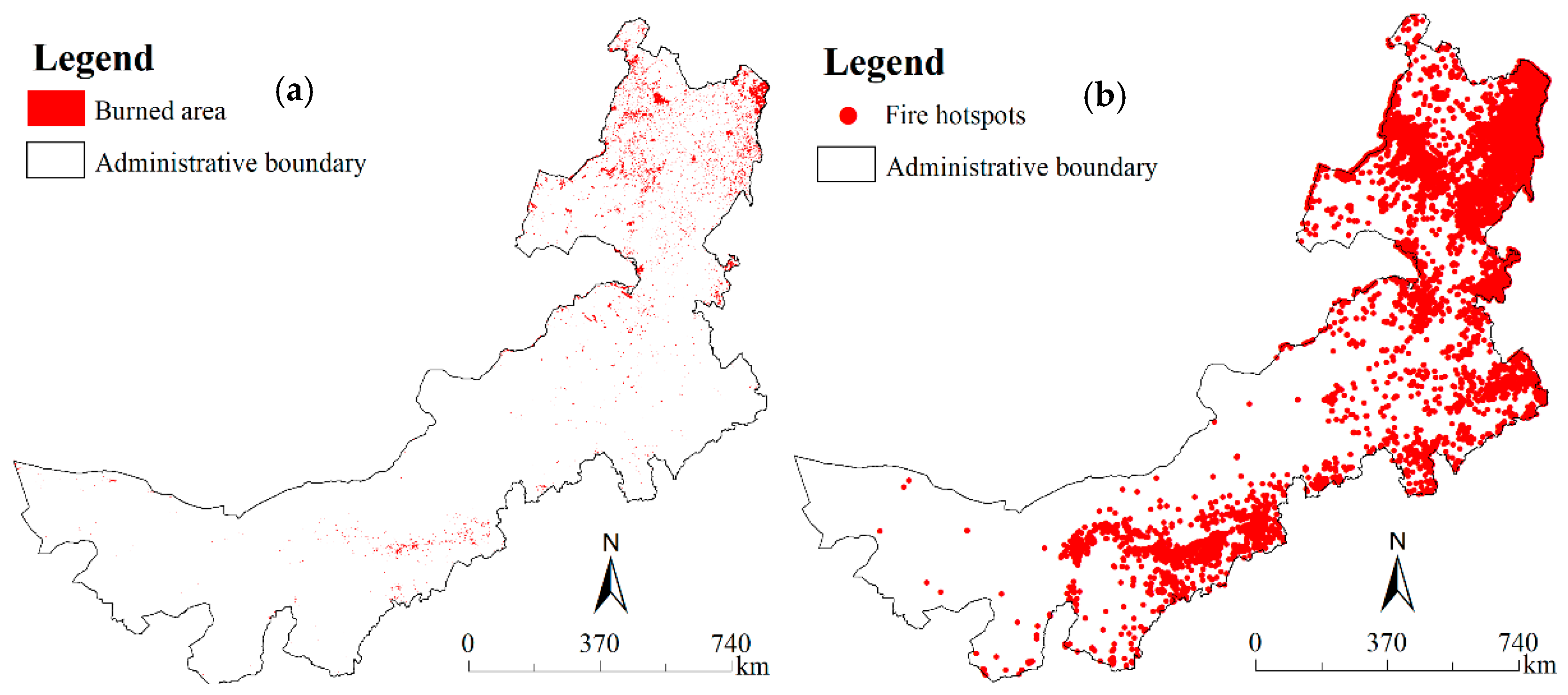

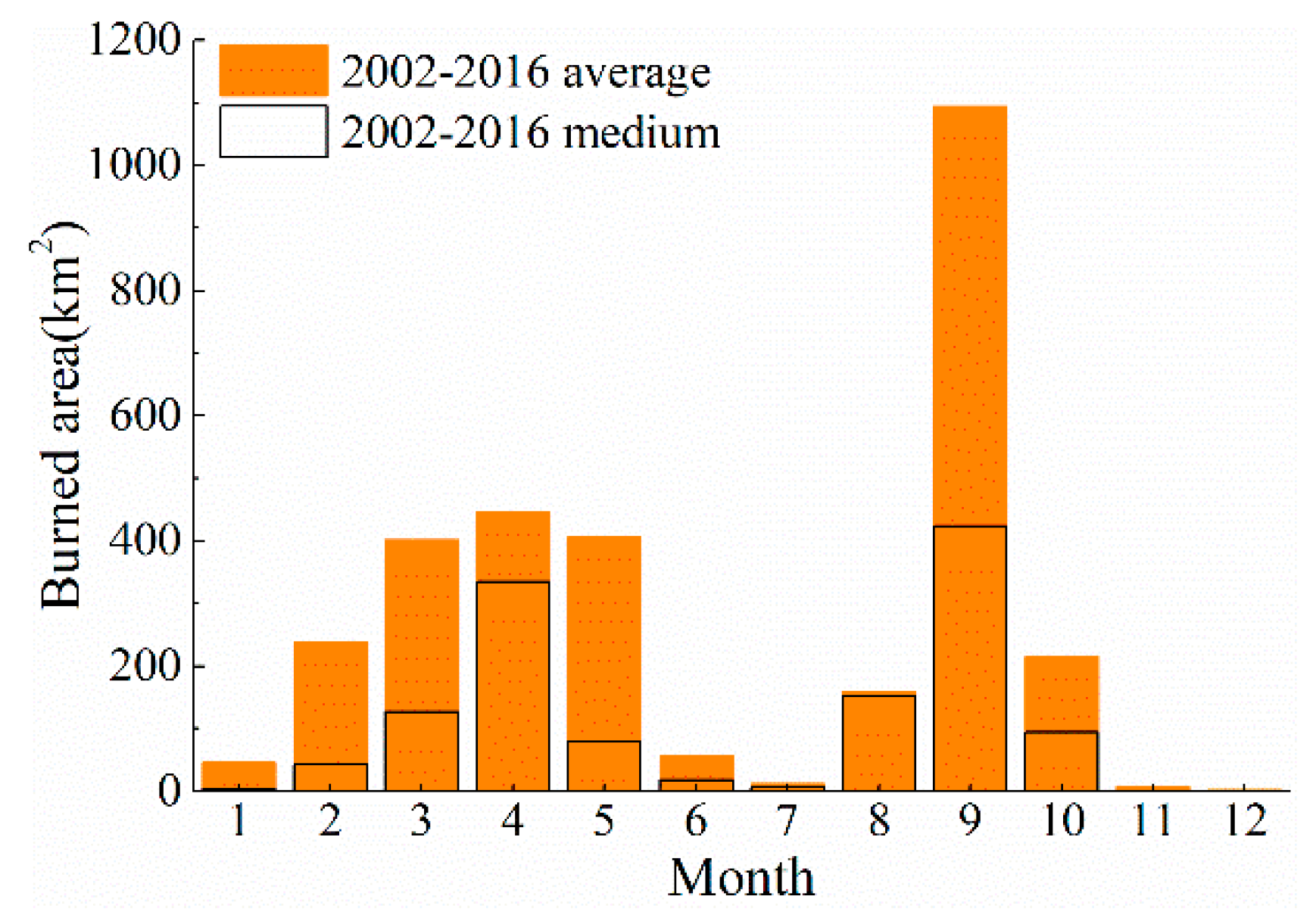
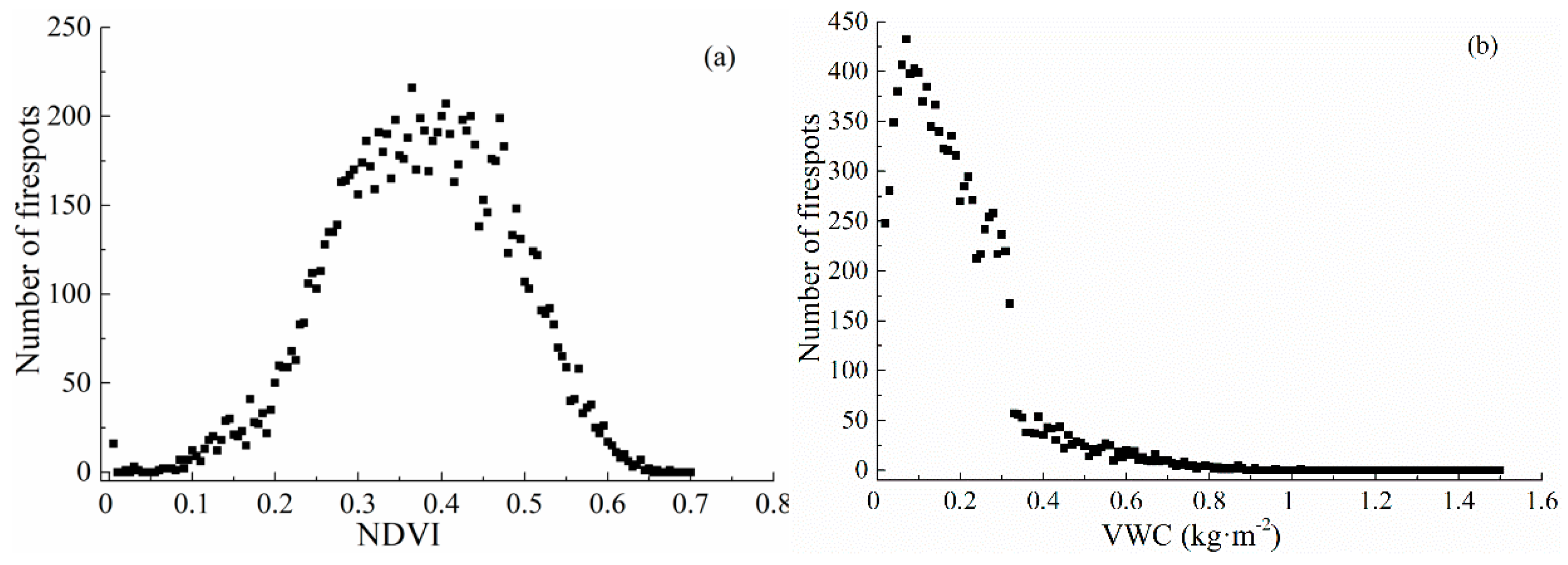
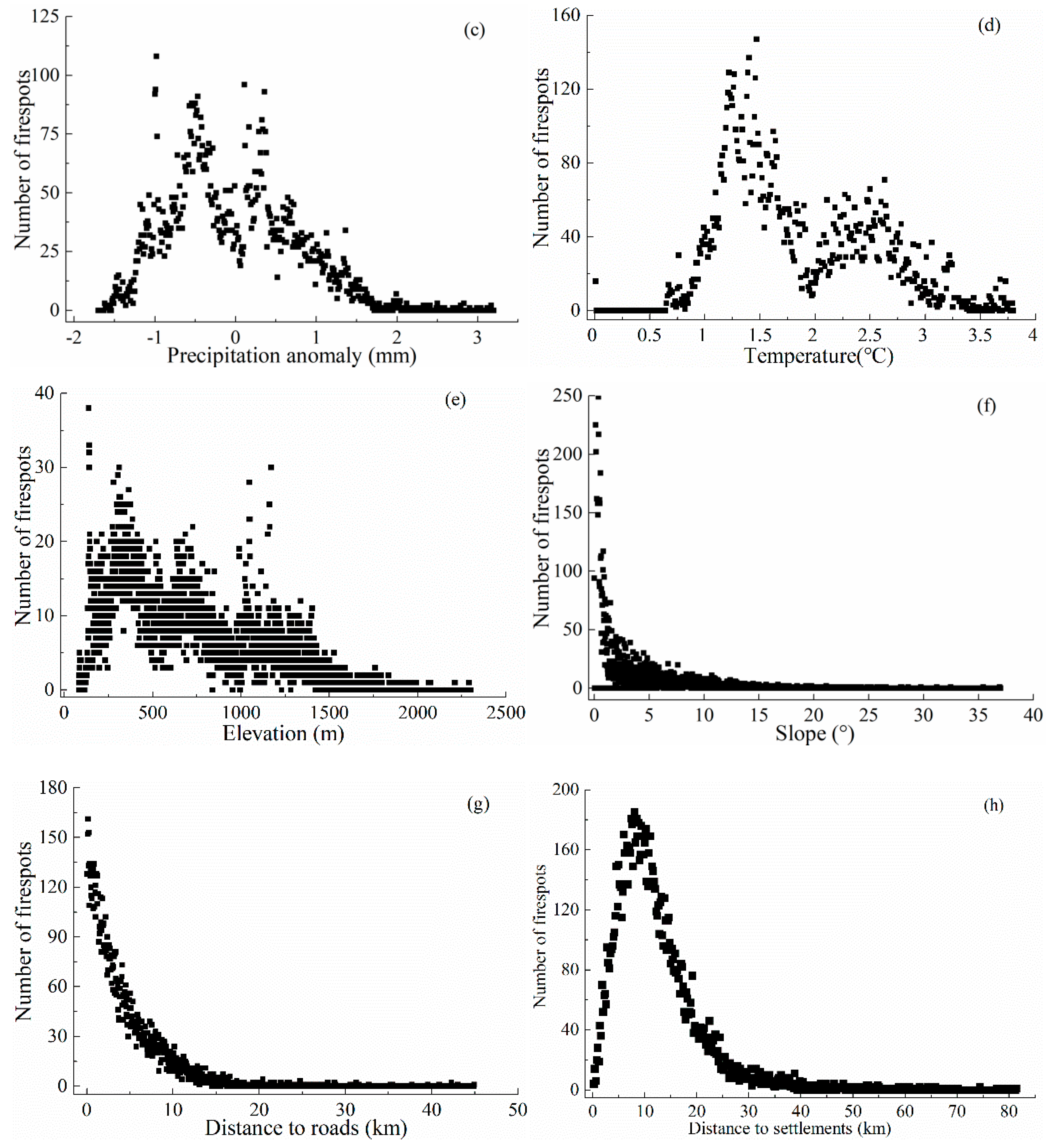
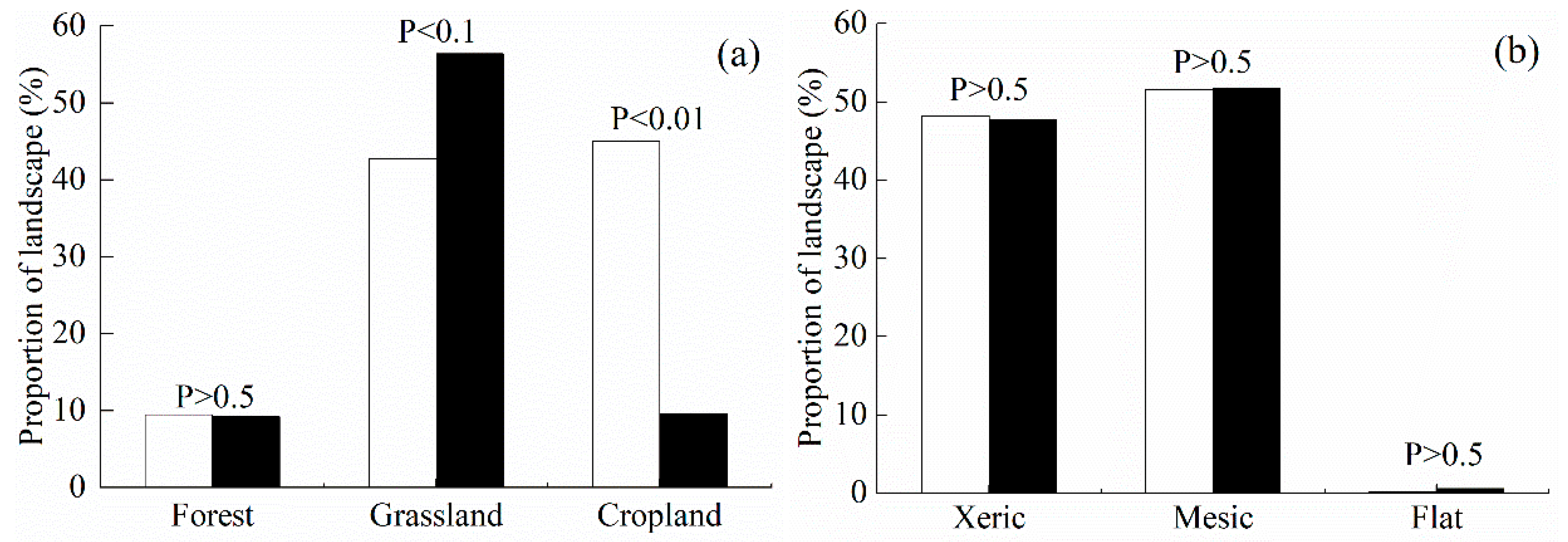


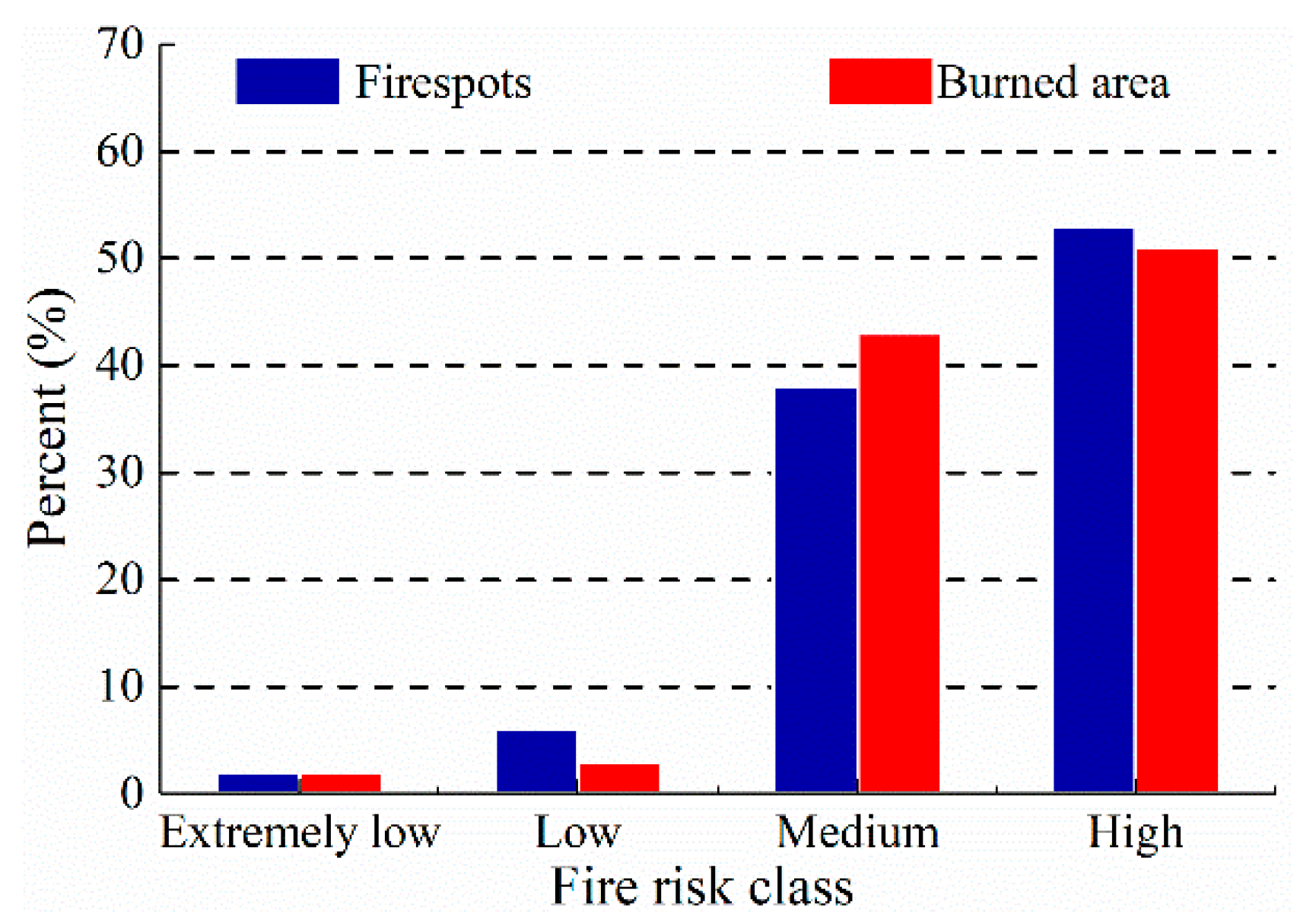
| Attribute Value | Corresponding Meaning | Attribute Value | Corresponding Meaning |
|---|---|---|---|
| 0 | Unprocessed pixel | 5 | Non-fire bare land pixel |
| 1 | Unprocessed pixel | 6 | Unknown pixel |
| 2 | Unprocessed pixel | 7 | low confidence, land or water |
| 3 | Water pixel | 8 | middle confidence, land or water |
| 4 | Cloud | 9 | high confidence, land or water |
| Fire Time (Year-Month-Day) | Fire Place | Fire Type | Image Selection Time (Year-Month-Day) | Data Source | Resolution (m) |
|---|---|---|---|---|---|
| 2005-10-16 | East Wuzhumuqin County | Grassland fire | 2005-10-22 | TM | 30 |
| 2006-05-25 | Hulunbuir, Mianduhe Town | Forest fire | 2006-06-03 | TM | 30 |
| 2012-04-19 | Chenba’erhu County, Wendu’er Village | Grassland fire | 2012-05-01 | ETM+ | 30 |
| 2014-04-01 | West Wuzhumuqin County, Bayanhua Town | Grassland fire | 2014-04-05 | ETM+ | 30 |
| Code | Variable Name | Data Source | Type | Units | Resolution |
|---|---|---|---|---|---|
| Climatic factors | |||||
| Tem | Mean temperature (fire season) | China Meteorological Data Service Center | Dynamic | °C | 500 m |
| Pre | Precipitation anomaly (fire season) | China Meteorological Data Service Center | Dynamic | mm | 500 m |
| Vegetation features | |||||
| LT | Land use types | National Aeronautics and Space Administration | Dynamic | Class 1–17 | 500 m |
| NDVI | NDVI (fire season) | National Aeronautics and Space Administration | Dynamic | Dimensionless (range: −1–1) | 500 m |
| VWC | Vegetation water content (fire season) | Calculated based on algorithm described by Thomas J. Jackson (1999) | Dynamic | kg·m−2 | 500 m |
| Topographic factors | |||||
| Ele | Elevation | Geospatial Data Cloud | Static | m | 90 m |
| Slo | Slope | Derived from elevation | Static | ° | 90 m |
| Asp | Aspect | Derived from elevation | Static | Class 1–8 | 90 m |
| Human influence | |||||
| DisRd | Distance to roads | Paper map of Inner Mongolia produced by China Cartographic Publishing House | Static | m | 500 m |
| DisSet | Distance to settlement areas | Paper map of Inner Mongolia produced by China Cartographic Publishing House | Static | m | 500 m |
© 2019 by the authors. Licensee MDPI, Basel, Switzerland. This article is an open access article distributed under the terms and conditions of the Creative Commons Attribution (CC BY) license (http://creativecommons.org/licenses/by/4.0/).
Share and Cite
Jia, X.; Gao, Y.; Wei, B.; Wang, S.; Tang, G.; Zhao, Z. Risk Assessment and Regionalization of Fire Disaster Based on Analytic Hierarchy Process and MODIS Data: A Case Study of Inner Mongolia, China. Sustainability 2019, 11, 6263. https://doi.org/10.3390/su11226263
Jia X, Gao Y, Wei B, Wang S, Tang G, Zhao Z. Risk Assessment and Regionalization of Fire Disaster Based on Analytic Hierarchy Process and MODIS Data: A Case Study of Inner Mongolia, China. Sustainability. 2019; 11(22):6263. https://doi.org/10.3390/su11226263
Chicago/Turabian StyleJia, Xu, Yong Gao, Baocheng Wei, Shan Wang, Guodong Tang, and Zhonghua Zhao. 2019. "Risk Assessment and Regionalization of Fire Disaster Based on Analytic Hierarchy Process and MODIS Data: A Case Study of Inner Mongolia, China" Sustainability 11, no. 22: 6263. https://doi.org/10.3390/su11226263
APA StyleJia, X., Gao, Y., Wei, B., Wang, S., Tang, G., & Zhao, Z. (2019). Risk Assessment and Regionalization of Fire Disaster Based on Analytic Hierarchy Process and MODIS Data: A Case Study of Inner Mongolia, China. Sustainability, 11(22), 6263. https://doi.org/10.3390/su11226263





